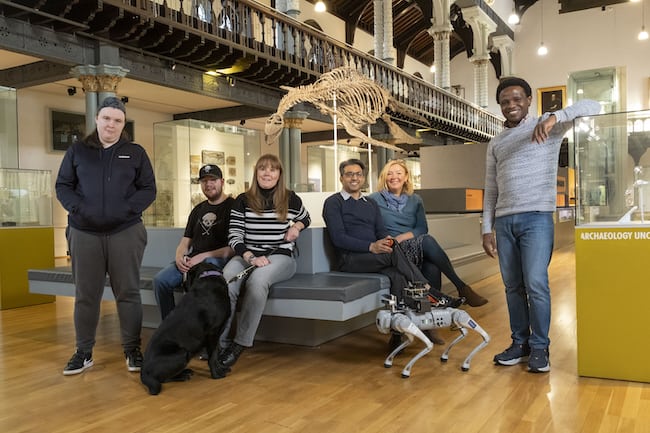Video: Assistive robot guide dog could soon help blind people navigate indoor spaces

Experts from the University of Glasgow, with support from The Forth Valley Sensory Centre (FVSC) Trust and the Royal National Institute of Blind People (RNIB) Scotland, are developing an assistive robot guide dog that could soon help blind and partially sighted people to navigate indoor spaces.
RoboGuide is an AI-powered four-legged robot that aims to help visually impaired people move more independently through museums, shopping centres, hospitals, and other public places in the future.
The assistive technology prototype integrates a range of “cutting-edge” technologies into an off-the-shelf robot body to help overcome the challenges preventing robots from being more widely used to assist blind and partially sighted people.
The project aims to bring a more complete version of the technology to market in the future to help support people with vision impairments.
Prof Muhammad Imran, Dean of graduate studies at the University of Glasgow’s James Watt School of Engineering, is a co-investigator on the project.
He said: “Our assistive technology project for the visually impaired embodies innovation, fostering inclusivity. In Glasgow, we’re pioneering world-changing technologies that hold the potential to transform lives and reshape societal norms. This achievement was made possible through collaboration with industry and charity partners and co-creating the design with the invaluable input of end users.”
Dr Olaoluwa Popoola, of the University of Glasgow’s James Watt School of Engineering, is the RoboGuide project’s principal investigator.
He said: “Assistive technologies like the RoboGuide have the potential to provide blind and partially sighted people with more independence in their daily lives in the years to come.
“One significant drawback of many current four-legged, two-legged and wheeled robots is that the technology which allows them to find their way around can limit their usefulness as assistants for the visually impaired.
“Robots which use GPS to navigate, for example, can perform well outdoors, but often struggle in indoor settings, where signal coverage can weaken. Others, which use cameras to ‘see’, are limited by line of sight, which makes it harder for them to safely guide people around objects or around bends.”
The RoboGuide system uses a series of sophisticated sensors mounted on the robot’s exterior to accurately map and assess its surroundings. Software developed by the team help it learn the optimal routes between locations and interpret the sensor data in real-time to help the robot avoid the many moving obstacles it might encounter while guiding a human.
RoboGuide also incorporates large language model technology, lending it the ability to understand questions and comments from users and provide verbal responses in return.
Learn more about the assistive robot guide dog in the video below:
Dr Wasim Ahmad, of the James Watt School of Engineering, is a co-investigator on the project.
He commented: “We’re pleased to be working closely with the FVSC and RNIB Scotland to test the RoboGuide in real-world environments, and to integrate their feedback into more refined iterations of the technology.
“Ultimately, our aim is to develop a complete system which can be adapted for use with robots of all shapes and sizes to help blind and partially sighted people in a wide range of indoor situations. We hope that we can create a robust commercial product which can support the visually impaired wherever they might want extra help.”
The nine-month research project is supported by funding from the Engineering and Physical Sciences Research Council (EPSRC), part of UKRI, through the Impact Acceleration Account programme.

